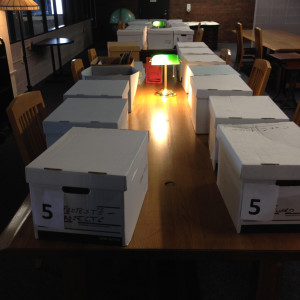 Peace Abbey Archives and Permanent Collection
Peace Abbey Archives and Permanent Collection
The Peace Abbey and The Life Experience School gifted over 40 years of archival materials to the University of Massachusetts Boston in July of 2012. Twenty-six boxes of documents, photographs, CDs, videos, correspondence, newspaper articles, personal effects of notable pacifists and Courage of Conscience Award materials are available for peace and justice research and for public viewing at the Healey Library, University of Massachusetts Boston.
Visit the Peacemakers Table, the protest model of the 9 foot Gandhi Statue and the busts of Oscar Romero, Samantha Smith, Gandhi and Emily the Cow at UMB.
The archival holdings are in the following categories:
Peace Abbey Letters and Correspondence
Clip Board Notes and Messages
Display Case Materials
Courage of Conscience Awards
Emily the Cow
The Pacifist Memorial
Peace Pilgrim
Newspaper articles
Photographs
University Archives and Special Collections is open for onsite research Monday – Friday, 10:00 am to 4:00 pm. Please contact library.archives@umb.edu to schedule an appointment or to request reference assistance, and consult our online collections and Finding Aids at http://OpenArchives.umb.edu.
Information regarding the Peace Abbey founding director:
Lewis Randa (Des Moines, IA, 10-24-1947) is a Quaker, pacifist, vegan, educator, and social change activist best known as the founder and director of several organizations dedicated to peace, nonviolence, and service. He established The Life Experience School in 1972 for children and young adults with disabilities, and later founded The Peace Abbey in 1988, an interfaith center in Massachusetts focused on the study and practice of nonviolence and pacifism. Randa also created the Pacifist Memorial (1994), the Special Peace Corps (1990), and the Veganpeace Animal Sanctuary (1995), among other initiatives.
.
Throughout his career, Randa has organized demonstrations, protests, and programs that empower individuals to pursue peace and justice, often employing the arts and public action as tools for activism. He remains active as the Executive Director of the Peace Abbey Foundation and continues to advocate for nonviolent social change.
.
Lewis Randa’s actions challenge traditional views of civil disobedience and activism in several key ways: Emphasis on Proportionality and Collective Impact: Randa advocates for coordinated, peaceful civil disobedience that can have a disproportionate impact on the system, such as deliberately occupying court time to draw attention to injustice. He suggests that if even a small percentage of people engage in such acts, their collective influence could surpass that of standard political participation like voting.
.
Necessity Defense and Moral Justification: Randa encourages activists to use the “necessity defense”—arguing that breaking the law was the only viable way to prevent greater harm—thus framing civil disobedience as a morally justifiable action rather than mere lawbreaking.
.
Personal Sacrifice and Creative Expression: He highlights the importance of personal risk and sacrifice in activism, suggesting that such commitment inspires others and can drive meaningful change. Randa’s approach blends traditional protest with creative, conscience-driven acts, expanding the boundaries of what civil disobedience can look like.
.
Nonviolent but Direct Confrontation: While rooted in nonviolence, Randa’s activism is confrontational and public, challenging not just laws but the broader social and political systems that uphold injustice. His willingness to face legal consequences—such as being arraigned for nonviolent protest—demonstrates a principled, transparent approach that goes beyond symbolic gestures.
.
By combining these elements, Randa moves beyond classic models of civil disobedience (like those of Thoreau, Gandhi, or King) and adapts activism to modern challenges, emphasizing ethical proportionality, collective action, and the transformative power of personal conscience.
.
Veganism plays a significant and deeply personal role in Lewis Randa’s life and activism. As a committed vegan, Randa integrates compassion for animals directly into his philosophy of nonviolence and peace. This is evident in several aspects:
.
Foundation of the Veganpeace Animal Sanctuary: Randa and his wife Meg established this sanctuary after rescuing Emily the Cow, who became a powerful symbol of courage, survival, and the possibility of a world beyond cruelty. The sanctuary and the story of Emily have inspired many to consider vegetarianism and cruelty-free living, reflecting Randa’s belief in the sacredness of all life.
.
Animal Rights Memorials: At the Peace Abbey, Randa created memorials—such as the life-size bronze statue of Emily the Cow—to honor animals and promote vegetarianism, humanity, and nonviolence. These memorials serve as “potent seed-planters for peace, vegan living, and inspiration for a world beyond war and injustice”.
.
Daily Expression of Compassion: Randa’s commitment to veganism is described as a daily practice of compassion, aligning with his broader advocacy for nonviolence and inclusion. His lifestyle choices reinforce his message that peace and justice extend to all living beings, not just humans.
.
Integration with Peace Work: Veganism is not separate from Randa’s other activism; instead, it is interwoven with his efforts for social justice, inclusion, and nonviolent protest. His animal rights advocacy is a natural extension of his Quaker and pacifist beliefs, emphasizing respect for all forms of life.
.
In summary, veganism profoundly shapes Randa’s worldview, guiding both his personal choices and his public initiatives, and reinforcing his lifelong dedication to nonviolence, compassion, and universal justice.
THE PEACE ABBEY FOUNDATION | 16 Lavender Street, Millis, MA 02054 | 508.655.2143 | admin@peaceabbey.org
 Peace Abbey Archives and Permanent Collection
Peace Abbey Archives and Permanent Collection